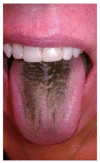Black hairy tongue syndrome
- PMID: 25152586
- PMCID: PMC4138463
- DOI: 10.3748/wjg.v20.i31.10845
Black hairy tongue syndrome
Abstract
Black hairy tongue (BHT) is a benign medical condition characterized by elongated filiform lingual papillae with typical carpet-like appearance of the dorsum of the tongue. Its prevalence varies geographically, typically ranging from 0.6% to 11.3%. Known predisposing factors include smoking, excessive coffee/black tea consumption, poor oral hygiene, trigeminal neuralgia, general debilitation, xerostomia, and medication use. Clinical presentation varies but is typically asymptomatic, although aesthetic concerns are common. Differential diagnosis includes pseudo-BHT, acanthosis nigricans, oral hairy leukoplakia, pigmented fungiform papillae of the tongue, and congenital melanocytic/melanotic nevi/macules. Clinical diagnosis relies on visual observation, detailed history taking, and occasionally microscopic evaluation. Treatment involves identification and discontinuation of the offending agent, modifications of chronic predisposing factors, patient's re-assurance to the benign nature of the condition, and maintenance of adequate oral hygiene with gentle debridement to promote desquamation. Complications of BHT (burning mouth syndrome, halitosis, nausea, gagging, dysgeusia) typically respond to therapy. Prognosis is excellent with treatment of underlying medical conditions. BHT remains an important medical condition which may result in additional burden on the patient and health care system and requires appropriate prevention, recognition and treatment.
Keywords: Black hairy tongue; Hyperkeratosis of the tongue; Lingua villosa nigra.
Figures
References
-
- Pegum JS. Urea in the treatment of black hairy tongue. Br J Dermatol. 1971;84:602. - PubMed
-
- Poulopoulos AK, Antoniades DZ, Epivatianos A, Grivea IN, Syrogiannopoulos GA. Black hairy tongue in a 2-month-old infant. J Paediatr Child Health. 2008;44:377–379. - PubMed
-
- Prinz H. Black tongue. Br Dent J. 1925;46:1265–1274.
-
- Pigatto PD, Spadari F, Meroni L, Guzzi G. Black hairy tongue associated with long-term oral erythromycin use. J Eur Acad Dermatol Venereol. 2008;22:1269–1270. - PubMed
-
- Powell FC. Glossodynia and other disorders of the tongue. Dermatol Clin. 1987;5:687–693. - PubMed
Publication types
MeSH terms
Supplementary concepts
LinkOut - more resources
Full Text Sources
Other Literature Sources




